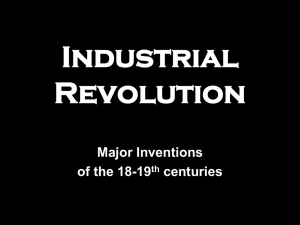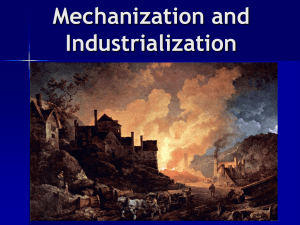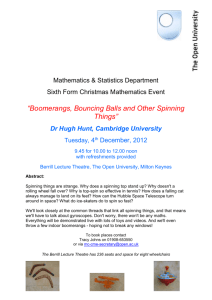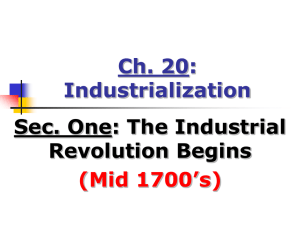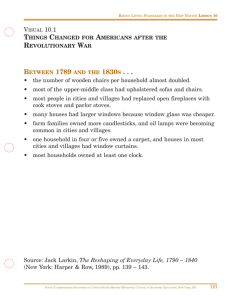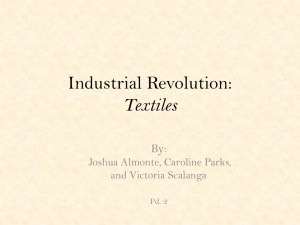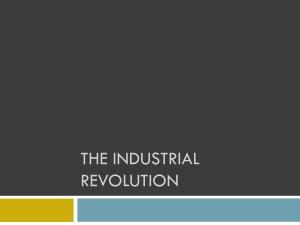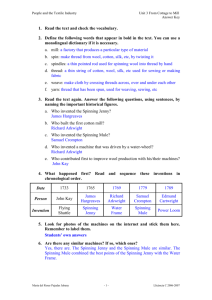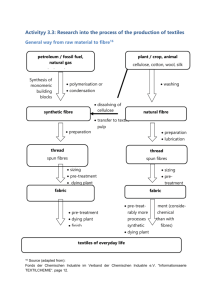World History Industrial Revolution Test 1. The Industrial Revolution
advertisement
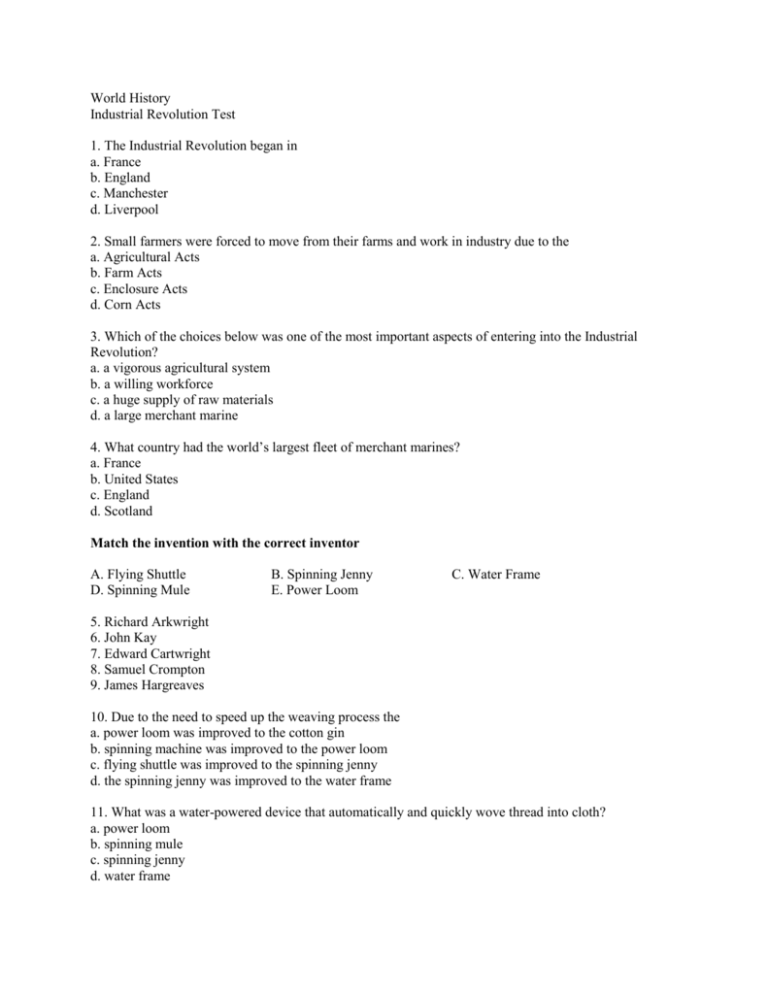
World History Industrial Revolution Test 1. The Industrial Revolution began in a. France b. England c. Manchester d. Liverpool 2. Small farmers were forced to move from their farms and work in industry due to the a. Agricultural Acts b. Farm Acts c. Enclosure Acts d. Corn Acts 3. Which of the choices below was one of the most important aspects of entering into the Industrial Revolution? a. a vigorous agricultural system b. a willing workforce c. a huge supply of raw materials d. a large merchant marine 4. What country had the world’s largest fleet of merchant marines? a. France b. United States c. England d. Scotland Match the invention with the correct inventor A. Flying Shuttle D. Spinning Mule B. Spinning Jenny E. Power Loom C. Water Frame 5. Richard Arkwright 6. John Kay 7. Edward Cartwright 8. Samuel Crompton 9. James Hargreaves 10. Due to the need to speed up the weaving process the a. power loom was improved to the cotton gin b. spinning machine was improved to the power loom c. flying shuttle was improved to the spinning jenny d. the spinning jenny was improved to the water frame 11. What was a water-powered device that automatically and quickly wove thread into cloth? a. power loom b. spinning mule c. spinning jenny d. water frame 12. What was a hand-operated machine which increased the speed of weaving? a. water frame b. flying shuttle c. spinning jenny d. spinning mule 13. What combined the spinning jenny and the water frame into a single device, increasing the production of fine thread? a. power loom b. spinning mule c. spinning jenny d. water frame 14. Who was the first to smelted iron by using water-powered air pumps to create steam blasts? a. Henry Cort b. Abraham Darby c. John Smeaton d. Eli Whitney 15. Who developed the puddling process which purified and strengthened molten iron a. Henry Cort b. Abraham Darby c. John Smeaton d. Eli Whitney 16. Thomas Telford and John McAdam are associated with a. the diesel engine b. the gasoline engine c. the locomotive d. macadamized roads Match the inventor with the invention A. Vladimir Zworykin B. Lee deForest D. Cyrus Field E. Samuel Morse C. Guglielmo Marconi 17. wireless telegraph 18. radio tube 19. television 20. Atlantic cable 21. telegraph Match the inventor with the invention A. Jethro Tull D. Justin von Liebig 22. fertilizers 23. crop rotation 24. cotton gin 25. seed drill 26. stock breeding B. Lord Townshend E. Eli Whitney C. Robert Blakewell 27. All of the following were political changes due to the Industrial Revolution except a. Decline of landed aristocracy b. Rise of business people c. Development and growth of cities d. Growth and expansion of democracy 28. Social changes included all except a. Increase in leisure time b. Population increases c. Nationalism and imperialism stimulated d. Science and research stimulated 29. Which of the following was an American inventor? a. James Hargreaves b. Robert Blakewell c. Elias Howe d. Richard Arkwright 30. Political changes during the Industrial Revolution included all of the following except a. Established minimum wage b. Standards for working conditions c. Rural to urban migration d. Forms of social security 31. What was not a problem faced with social change during the Industrial Revolution? a. minimum wage established b. monotony of assembly line c. loss of craftsmanship in manufactured goods d. war became more deadly due to improved weapons 32. Some of the social changes that happened during the Industrial revolution were labor saving devices which included all of the following except a. refrigerators b. washing machines c. talkies d. vacuum cleaners 33. Legal protection for workers during the Industrial Revolution included all except a. legal protection for women b. end of child labor c. minimum wage d. company towns for workers to live in Which of the following was a 34. Individual bargaining 35. Collective bargaining 36. Pickets 37. Lockouts A. weapon by the unions B. a weapon used by employers 38. Strikes 39. Union labels 40. Yellow-dog contracts 41. Right-to-Work-Laws 42. Boycotts 43. Open Shops 44. Injunctions 45. Feather-bedding 46. Which union’s intent was to overthrow capitalism? a. International Workers of the World b. American Federation of labor c. Congress of Industrial Organizations d. Knights of Labor 47. Which president fired air traffic controllers when they went on strike? a. Ronald Reagan b. Bill Clinton c. Richard Nixon d. George Bush 48. What was a unsanitary building with multiple dwellings? a. company town b. union shop c. tenement d. closed shop 49. What invention during the Industrial Revolution brought the work to the worker? a. unions b. interchangeable parts c. the assembly line d. mill towns 50. What is put in place to limit foreign competition within an industrialized nation and its colonies? a. protective tariffs b. free trade c. interchangeable parts d. mechanical reapers
